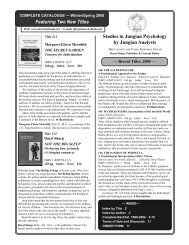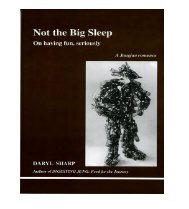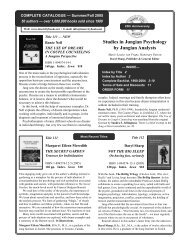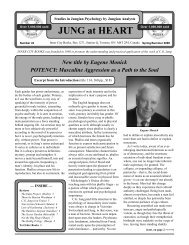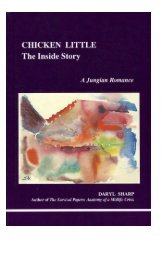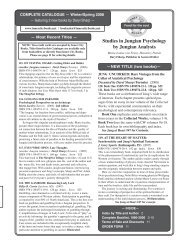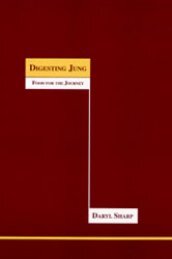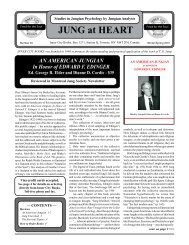Personality types: Jung's model of typology - Inner City Books
Personality types: Jung's model of typology - Inner City Books
Personality types: Jung's model of typology - Inner City Books
- No tags were found...
Create successful ePaper yourself
Turn your PDF publications into a flip-book with our unique Google optimized e-Paper software.
Introduction to Jungian Typology 13adaptation. In the former, the movement <strong>of</strong> energy is towardthe inner world. In the latter, interest is directed toward theouter world. In one case the subject (inner reality) and in theother the object (things and other people, outer reality) is <strong>of</strong>primary importance.Introversion, writes Jung, "is normally characterized by ahesitant, reflective, retiring nature that keeps itself to itself,shrinks from objects [and] is always slightly on the defensive."2Conversely, extraversion "is normally characterized by anoutgoing, candid, and accommodating nature that adapts easilyto a given situation, quickly forms attachments, and, settingaside any possible misgivings, will <strong>of</strong>ten venture forthwith careless confidence into unknown situations." 3In the extraverted attitude, external factors are the predominantmotivating force for judgments, perceptions, feelings,affects and actions. This sharply contrasts with the psychologicalnature <strong>of</strong> introversion, where internal or subjectivefactors are the chief motivation.Extraverts like to travel, meet new people, see new places.They are the typical adventurers, the life <strong>of</strong> the party, openand friendly. The introvert is essentially conservative, preferringthe familiar surroundings <strong>of</strong> home, intimate times with afew close friends. To the extravert, the introvert is a stick-inthemud, a spoil-sport, dull and predictable. Conversely, theintrovert, who tends to be more self-sufficient than the extravert,might describe the latter as flighty, a superficial gadabout.In practice, it is not possible to demonstrate the introvertedand extraverted attitudes per se, that is in isolation. Whether aperson is one way or the other only becomes apparent in asso-2 Two Essays on Analytical Psychology, CW 7, par. 62.3 Ibid.



